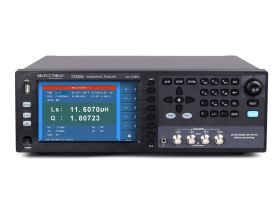Certified quality management system
ST2836 LCR Meter
The ST2836 is a precision LCR measuring bridge characterized by a high measurement frequency of 8.5 MHz, speed, and versatility. Thanks to its 5‑terminal configuration, highly accurate measurements can be made with minimal influence from contact and lead resistances. In addition to this ultra‑high precision, the bridge also offers the capability to complete a measurement cycle in less than 6 milliseconds. Fast and accurate results are essential for demanding industrial applications. Common use cases include production lines—such as in the automotive sector—test labs, and R&D departments.
- Accuracy: 0.05%
- Frequency range: 4 Hz - 8.5 MHz
- Measuring speed: 5.6ms
- DCR: 0.00001 Ω - 99.9999 MΩ
- Resolution: 6 digits
- Display: Color TFT 7”
- DC bias: ±10 V
- Interfaces: USB, LAN, RS232C, Handler, optional: GPIB
- Extra: incl. accessories
Designed to provide high accuracy across a broad frequency range at a much more affordable price than the even more precise ST2839, this bridge delivers measurement results with up to 0.05 % accuracy. A 7‑inch display with 800 × 480‑pixel resolution ensures a clear presentation of all relevant measurement data. The integrated 10‑point multi‑parameter list‑sweep function enables simultaneous analysis of multiple parameters, while mathematical operation functions allow complex evaluations directly on the instrument. An automatic polarity feature is available for specialized measurements, such as varactor diodes.
Moreover, the device includes convenient features like one‑button screenshot and one‑button recording functions. A 10‑level sorting function with audible and visual alarms facilitates component classification in production environments. The internal memory can store 40 configuration files, and via USB up to 500 additional files—including setup profiles, images, and measurement data—can be saved.
Another advantage is its high compatibility: the instrument supports SCPI commands, making it very easy to integrate into test systems.
Its range of applications is broad: from impedance and performance analysis of passive components like capacitors, inductors, and transformers; testing of parasitic parameters in semiconductor devices; to evaluation of PCBs, relays, cables, or batteries. It can also reliably capture dielectric properties of materials such as plastics and ceramics and magnetic characteristics of ferrites and amorphous metals. Additionally, the instrument is suitable for investigating C‑V behavior and other electrical parameters of semiconductor materials and LCD modules.
Thanks to this wide range of functions and precision, the instrument is an ideal solution for development, laboratory, and production environments requiring detailed component and material characterization.

